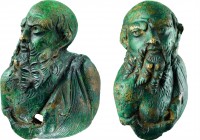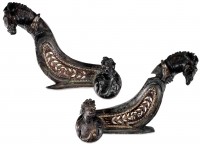 A metal detectorist has discovered a bronze figure of Silenus on the island of Falster in southeastern Denmark. When she first unearthed the bust of a togate, bearded figure, the metal detectorist thought it was a modern piece because it was so finely crafted and in such good condition. It wasn’t until she showed it to experts at the National Museum of Denmark that it was properly identified as a Roman bronze from the 1st century A.D.
A metal detectorist has discovered a bronze figure of Silenus on the island of Falster in southeastern Denmark. When she first unearthed the bust of a togate, bearded figure, the metal detectorist thought it was a modern piece because it was so finely crafted and in such good condition. It wasn’t until she showed it to experts at the National Museum of Denmark that it was properly identified as a Roman bronze from the 1st century A.D.
The figure is small at just 4.5 centimeters (1.8 inches) high and depicts Silenus, the tutor and boon companion of Bacchus. Silenus is portrayed as an old man, bald and bearded, with thick lips and a squashed nose. He is the wisest of the god’s followers and, appropriately, also the drunkest, so drunk that he is usually shown riding a mule or being supported by satyrs.
 The Romans often used Bacchic themes in their dining room decoration and this Silenus was originally part of a lectus, the couch or bed on which diners reclined. Lecti had s-shaped headrest supports called fulcra (plural for fulcrum) on both sides. Usually made of bronze, fulcra were richly decorated, inlaid with precious metals and/or ivory. Each end of the fulcrum culminated in a sculpted figure. Satyrs and sileni were popular for one end, while the other end was often topped with the head of a donkey or mule, a reference to Silenus’ preferred form of transportation. The British Museum has a beautiful pair of intact fulcra with satyrs and mules on the ends. You can see how the Falster Silenus’ turned position matches the satyrs’.
The Romans often used Bacchic themes in their dining room decoration and this Silenus was originally part of a lectus, the couch or bed on which diners reclined. Lecti had s-shaped headrest supports called fulcra (plural for fulcrum) on both sides. Usually made of bronze, fulcra were richly decorated, inlaid with precious metals and/or ivory. Each end of the fulcrum culminated in a sculpted figure. Satyrs and sileni were popular for one end, while the other end was often topped with the head of a donkey or mule, a reference to Silenus’ preferred form of transportation. The British Museum has a beautiful pair of intact fulcra with satyrs and mules on the ends. You can see how the Falster Silenus’ turned position matches the satyrs’.
Originating in Greece, the lectus reached its peak of popularity in the early Roman Empire. No wealthy person’s triclinium (dining room) was complete without three lecti arranged in a U shape at right angles to each other. In fact, the “tri” in triclinium is a reference to the three lecti. The Walters Art Museum in Baltimore has a complete set of bronze lectus fittings from the late Republic, early Empire that they have put together with modern wood elements so you can see the architecture of the frame. In its day, it would have been topped with a mattress and sumptuous textiles and cushions.
 These furnishings were expensive, highly prized pieces, so much so that they would sometimes be buried with their owners. That’s unlikely to have been the case with the Falster Silenus. It probably was separated from its bed long before it wound its way into the soil of Denmark. The Roman furniture fittings that have been discovered in Denmark thus far appear to have been individual objects rather than part of a larger piece, brought to the area as art works or war booty.
These furnishings were expensive, highly prized pieces, so much so that they would sometimes be buried with their owners. That’s unlikely to have been the case with the Falster Silenus. It probably was separated from its bed long before it wound its way into the soil of Denmark. The Roman furniture fittings that have been discovered in Denmark thus far appear to have been individual objects rather than part of a larger piece, brought to the area as art works or war booty.
The number of Roman finds in the Danish islands south of Zealand may indicate an active trade network moving goods from southern Europe to Denmark, and there is some documentary support for contact during the early empire. In a passage from the Res Gestae Divi Augusti, an autobiographical summary written by Augustus during his lifetime for use on funerary inscriptions after his death, he dispatched ships to the peninsula of Jutland and established friendly relations with the locals.
My fleet sailed from the mouth of the Rhine eastward as far as the lands of the Cimbri to which, up to that time, no Roman had ever penetrated either by land or by sea, and the Cimbri and Charydes and Semnones and other peoples of the Germans of that same region through their envoys sought my friendship and that of the Roman people.
Fulcrum fittings weren’t a big part of that friendship, though. This is the first one that has ever been found in Denmark.